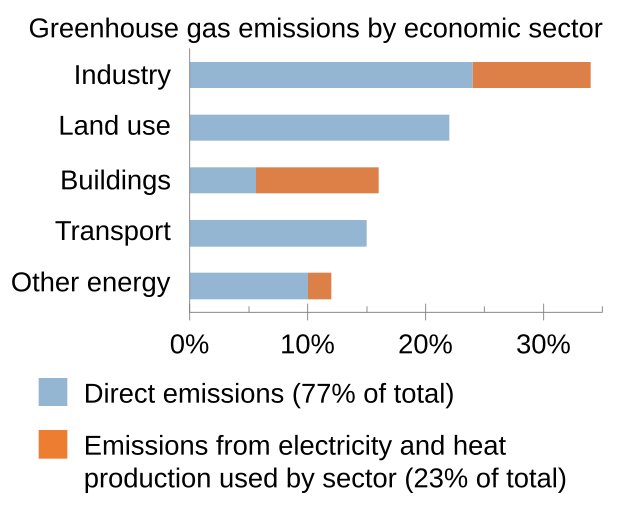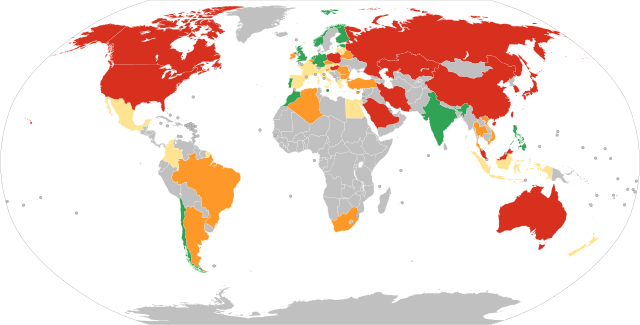热门问题
时间线
聊天
视角
气候变化
气候在一段时间内的波动变化 来自维基百科,自由的百科全书
Remove ads
现今的气候变化,既包含全球暖化(指全球地表温度持续上升的现象),也包含它对地球气候系统造成的广泛影响。从更广泛的意义上说,气候变化也涵盖了地球气候过去的长期变化。目前的全球气温上升,科学界有共识是由人类活动所驱动,特别是工业革命以来燃烧化石燃料(煤、石油和天然气)的结果。[1][2] 使用化石燃料、砍伐森林,以及某些农业和工业活动都会释放温室气体。[3] 地球吸收阳光变暖后,会向外散发热量,而这些气体会吸收其中一部分,使低层大气变暖,这就是温室效应。二氧化碳是导致全球暖化的主要气体,自前工业时代以来,其在大气中的浓度已增加了约50%,达到了数百万年来的最高水平。[4]
气候变化对环境的影响日益显著。沙漠正在扩张,热浪和山火也变得越来越普遍。[5] 北极地区的暖化加剧,导致永冻土融化、冰川退缩和海冰减少。[6] 气温升高也导致了更强烈的风暴、干旱和其他极端天气。[7] 山区、珊瑚礁和北极的环境快速变化,迫使许多物种迁移或走向灭绝。[8] 即使未来限制暖化的努力取得成功,有些影响仍将持续数个世纪,包括海洋暖化、海洋酸化和海平面上升。[9]
气候变化威胁著人类,带来更频繁的洪水、酷热、粮食和水源短缺、更多疾病以及经济损失。[10] 人类迁徙和冲突也可能因此而生。[11] 世界卫生组织称气候变化是21世纪对全球健康的最大威胁之一。[12] 如果不采取行动限制暖化,社会和生态系统将面临更严峻的风险。[13] 透过防洪措施或种植抗旱作物等方式适应气候变化,可以在一定程度上减轻风险,但某些适应措施已达到极限。[14] 较贫穷的社区虽然只占全球排放量的一小部分,但他们适应气候变化的能力最弱,也最容易受到冲击。[15][16]
在21世纪的头几十年里,人们已经观察到许多气候变化的影响,其中2024年是有纪录以来最热的一年,比1850年有常规纪录以来高出+1.60 °C(2.88 °F)。[18][19] 气温若持续上升,不仅会加剧这些影响,还可能触发临界点,例如格陵兰冰原的完全融化。[20] 根据2015年的《巴黎协定》,各国共同同意将全球暖化控制在“远低于2°C”的范围内。然而,即便各国履行现有的承诺,到本世纪末,全球气温仍可能上升约2.8 °C(5.0 °F)。[21]
全球范围内对气候行动的支持相当普遍,[22][23] 大多数国家都设定了实现净零排放的目标。[24] 要逐步淘汰化石燃料,可以透过停止化石燃料补贴、节约能源,以及转向低碳电力等方式达成。这些能源包括风能、太阳能、水力和核能。[25] 清洁电力可以取代化石燃料,为电动车、电热建筑和工业制程提供动力。[26] 此外,也可以透过移除大气中的碳来减缓暖化,例如增加森林覆盖率,或采用能将碳储存在土壤中的耕作方法。[27][28][29]
Remove ads
术语
在1980年代之前,科学家尚不确定增加温室气体的暖化效应是否强于空气污染中悬浮微粒的冷却效应。当时,他们使用“非故意的气候改造”(inadvertent climate modification)来指称人类对气候的影响。[30]
到了1980年代,“全球暖化”(global warming)和“气候变化”(climate change)这两个词变得更加普遍,且常常可以互换使用。[31][32][33] 从科学上讲,“全球暖化”仅指全球平均地表温度的上升,而“气候变化”则同时描述了全球暖化及其对地球气候系统的各种影响,例如降水模式的改变。[30]
“气候变化”也可以更广泛地用来指地球历史上发生的所有气候变动。[34] “全球暖化”一词最早可能在1975年就已出现[35],而在NASA气候科学家詹姆斯·汉森于1988年在美国参议院作证时使用后,这个词变得更加普及。[36] 自2000年代以来,“气候变化”的使用频率逐渐增加。[37] 一些科学家、政治人物和媒体可能会使用“气候危机”或“气候紧急状态”等词汇来讨论气候变化,并用“全球升温”(global heating)来代替“全球暖化”。[38][39]
Remove ads
全球温度上升

在过去的数百万年里,地球气候在冰期之间循环。其中一个较暖的时期是约12.5万年前的末次间冰期,当时的温度比全球暖化开始前高出0.5至1.5°C。[44] 那个时期的海平面比今天高出5到10公尺。而最近一次的末次冰盛期发生在约2万年前,当时的气温比现在低约5至7°C,海平面则比今天低了超过125米(410英尺)。[45]
从11,700年前开始,地球进入了目前的间冰期,气温趋于稳定。[46] 农业也在这个时期开始发展。[47] 历史上的一些暖期和冷期,如中世纪温暖时期和小冰期,并不是全球同步发生的。在某些有限的地区,当时的温度可能达到了20世纪末的水平。[48][49] 这些时期的气候资讯主要来自气候代理指标,例如树木年轮和冰芯。[50][51]


大约从1850年开始,温度计的纪录开始覆盖全球。[54] 从18世纪到1970年,全球净暖化幅度不大,因为温室气体排放的暖化效应被二氧化硫排放的冷却效应所抵消。二氧化硫会导致酸雨,但它也会在大气中形成硫酸盐悬浮微粒,这些微粒能反射阳光,造成全球暗化。1970年后,随著温室气体的持续累积和对硫污染的控制,气温显著上升。[55][56][57]
目前气候的持续变化,在过去几千年来都是前所未见的。[58] 多个数据集都显示全球地表温度正在上升,[59] 大约每十年上升0.2°C。[60] 与工业化前(1850-1900年)的基准相比,2014-2023这十年的平均温度上升了1.19°C [1.06–1.30°C]。[61] 并非每一年都比前一年更热,因为内部的气候变异过程可能使任何一年的温度比平均值高或低0.2°C。[62] 从1998年到2013年,太平洋年代际振荡(PDO)[63] 和大西洋多年代际振荡(AMO)[64]这两个过程的负相位导致了一段被称为“全球暖化停滞”的短暂暖化趋缓期。[65] 在这段“停滞期”之后,情况正好相反,2024年的气温远高于近期平均值,超过了+1.5°C。[66] 这就是为什么温度的变化通常以20年为平均值来定义,这样可以减少单一年份冷热和年代际气候模式的杂讯,从而侦测到长期的趋势。[67]:5[68]
许多其他的观测结果也印证了暖化的证据。[69][70] 高层大气正在冷却,因为温室气体将热量困在地表附近,导致较少的热量辐射到太空中。[71] 暖化减少了平均积雪覆盖,并迫使冰川退缩。同时,暖化也导致海洋蒸发加剧,使得大气湿度增加,降水也变得更多、更强。[72][73] 植物在春季开花的时间提前,数千种动物物种也已永久性地迁徙到较凉爽的地区。[74]
Remove ads
世界不同地区的暖化速度各不相同。这种模式与温室气体的排放地点无关,因为这些气体在大气中停留的时间足够长,可以扩散到全球。自工业化前时期以来,陆地区域的平均地表温度上升速度几乎是全球平均地表温度的两倍。[75] 这是因为海洋透过蒸发散失更多热量,并且海洋能够储存大量热量。[76] 自1970年以来,全球气候系统中的热能持续增长,其中超过90%的额外能量储存在海洋中。[77][78] 其馀的能量则加热了大气层、融化了冰雪,并使大陆变暖。[79]
北半球和北极的暖化速度远快于南极和南半球。北半球不仅陆地面积大得多,季节性积雪和海冰也更多。当这些表面从反射大量阳光变为冰融化后的深色表面时,它们开始吸收更多热量,这就是所谓的反照率效应。[80] 局部沉积在冰雪上的黑碳也加剧了北极的暖化。[81] 北极地表温度的上升速度是全球其他地区的三到四倍。[82][83] 极地冰盖的融化削弱了大西洋和南极的温盐环流,进一步改变了全球热量和降水的分布。[84][85][86][87]
Remove ads

世界气象组织估计,在2024年至2028年间,全球五年平均温度有近50%的机率会超过+1.5°C。[90] IPCC预计,20年平均温度将在2030年代初期超过+1.5°C。[91]
IPCC第六次评估报告(2021年)预测,到2100年,在温室气体极低排放情景下,全球暖化很可能达到1.0–1.8°C;在中等排放情景下为2.1–3.5°C;而在极高排放情景下则为3.3–5.7°C。[92] 在中等和高排放情景下,暖化将在2100年后继续持续,[93][94] 未来到了2300年,全球地表温度的预测值将与数百万年前相似。[95]
剩馀的碳预算(即在不超过特定升温幅度下还能排放的碳量)是透过模拟碳循环和气候敏感度来确定的。[96] 根据联合国环境署的说法,如果2023年后的排放量不超过9000亿吨CO2,那么将全球暖化控制在2.0°C以下的机率为50%。这个碳预算相当于目前排放水平下约16年的排放量。[97]
Remove ads
近期全球气温上升的原因

气候系统本身存在著各种周期,可持续数年、数十年甚至数百年。例如,圣婴现象会导致地表温度短期飙升,而反圣婴现象则会导致短期降温。[98] 它们的相对频率可以影响十年尺度的全球温度趋势。[99] 其他的气候变化则是由于外部强迫因素造成的能量不平衡所引起。[100] 这些强迫因素的例子包括温室气体浓度的变化、太阳光度的变化、火山爆发,以及地球绕太阳轨道的变化。[101]
为了确定人类对气候变化的贡献,科学家们为所有潜在原因建立了独特的“指纹”,并将其与观测到的模式和已知的内部气候变异进行比较。[102] 例如,太阳强迫的“指纹”是整个大气层都会变暖,但观测结果显示只有低层大气在变暖,因此排除了太阳是主要原因的可能性。[103] 大气中的悬浮微粒则产生较小的冷却效应。其他驱动因素,如反照率的变化,影响较小。[104]
Remove ads

温室气体对阳光是透明的,因此阳光可以穿过大气层加热地球表面。地球以热量的形式将能量辐射出去,而温室气体会吸收其中的一部分。这种吸收作用减缓了热量逸散到太空的速度,将热量困在地表附近,使地球随时间变暖。[105]
虽然水蒸气(约50%)和云(约25%)是温室效应的最大贡献者,但它们主要随温度变化而变化,因此大多被视为改变气候敏感度的反馈。另一方面,CO2(约20%)、对流层臭氧、[106] CFCs和一氧化二氮等气体的浓度变化与温度无关,因此被视为改变全球温度的外部强迫因素。[107]
在工业革命之前,自然存在的温室气体使地表附近的空气比没有它们时要温暖约33°C。[108][109] 自工业革命以来,人类活动,主要是开采和燃烧化石燃料(煤、石油、天然气),[110] 增加了大气中温室气体的含量。到2022年,CO2和甲烷的浓度分别比1750年增加了约50%和164%。[111] 这些CO2水平是过去1400万年来最高的。[112] 甲烷的浓度也远高于过去80万年的水平。[113]

2019年,全球人为温室气体排放量相当于590亿吨CO2当量。在这些排放中,75%是CO2,18%是甲烷,4%是一氧化二氮,2%是含氟气体。[114] CO2排放主要来自燃烧化石燃料,以提供交通、制造、供暖和发电所需的能源。[3] 额外的CO2排放来自砍伐森林和工业过程,包括制造水泥、钢铁、铝和化肥的化学反应所释放的CO2。[115][116][117][118] 甲烷排放来自牲畜、粪便、稻米种植、垃圾掩埋场、废水、煤矿开采,以及石油和天然气开采过程中的泄漏。[119][120] 一氧化二氮的排放主要来自化肥的微生物分解。[121][122]
虽然甲烷在大气中平均只停留12年,[123] 但CO2的停留时间要长得多。地球表面会吸收CO2,这是碳循环的一部分。虽然陆地和海洋中的植物每年会吸收大部分多馀的CO2排放,但当生物体被消化、燃烧或腐烂时,这些CO2又会回到大气中。[124] 陆地表面的碳汇过程,如土壤中的固碳作用和光合作用,每年约移除全球29%的CO2排放。[125] 在过去二十年中,海洋吸收了20%到30%的排放CO2。[126] CO2只有在储存于地壳中时才能长期从大气中移除,而这个过程可能需要数百万年才能完成。[124]
Remove ads

地球约30%的陆地面积基本上不适合人类使用(如冰川、沙漠等),26%是森林,10%是灌木林,34%是农业用地。[128] 砍伐森林是导致全球暖化的主要土地利用变迁因素,[129] 因为被砍伐的树木会释放CO2,而且没有新的树木来替代它们,从而减少了这个碳汇。[130] 在2001年至2018年间,27%的森林砍伐是为了永久性地开垦土地以扩大农作物和畜牧业的农业扩张。另外24%的森林损失是因刀耕火种农业系统下的临时性砍伐。26%是为了伐木以获取木材和相关产品,其馀23%则归因于山火。[131] 有些森林虽然没有被完全清除,但已经因这些影响而退化。恢复这些森林也能恢复它们作为碳汇的潜力。[132]
当地的植被覆盖会影响有多少阳光被反射回太空(反照率),以及有多少热量透过蒸散散失。例如,从深色的森林变为草地会使地表颜色变浅,从而反射更多阳光。砍伐森林还可能改变影响云层的化学物质释放,并改变风的模式。[133] 在热带和温带地区,净效应是产生显著的暖化,而森林恢复可以使局部温度降低。[132] 在更靠近极地的纬度地区,当森林被积雪覆盖(反射性更强)的平原取代时,会产生冷却效应。[133] 全球来看,地表反照率的增加是土地利用变化对温度最主要的直接影响。因此,迄今为止的土地利用变化估计产生了轻微的冷却效应。[134]
空气污染以悬浮微粒的形式,大规模地影响气候。[135] 悬浮微粒会散射和吸收太阳辐射。从1961年到1990年,观测到到达地球表面的日射量逐渐减少。这种现象通常被称为“全球暗化”,[136] 主要归因于燃烧含硫量高的化石燃料(如煤和船用燃油)所产生的硫酸盐悬浮微粒。[57] 较小的贡献来自黑碳(来自化石燃料和生物质的燃烧)和尘埃。[137][138][139] 自1990年以来,由于污染控制,全球悬浮微粒数量一直在下降,这意味著它们不再像以前那样能掩盖温室气体的暖化效应。[140][57]
悬浮微粒对地球能量收支也有间接影响。硫酸盐悬浮微粒充当云凝结核,导致云中含有更多、更小的云滴。这些云比含有较少、较大云滴的云更有效地反射太阳辐射。[141] 它们还会减缓雨滴的生长,使云对入射阳光的反射性更强。[142] 悬浮微粒的间接效应是辐射强迫中最大的不确定性来源。[143]
虽然悬浮微粒通常透过反射阳光来限制全球暖化,但落在雪或冰上的烟尘中的黑碳却可能加剧全球暖化。这不仅增加了阳光的吸收,还会加速融化和海平面上升。[144] 限制北极地区新的黑碳沉积,到2050年可将全球暖化减少0.2°C。[145] 自2020年起降低船用燃油的硫含量,估计到2050年将导致全球平均温度额外上升0.05°C。[146]
Remove ads

由于太阳是地球最主要的能量来源,入射阳光的变化会直接影响气候系统。[143] 太阳变异已由卫星直接测量,[149] 而间接测量则可追溯至17世纪初。[143] 自1880年以来,到达地球的太阳能量没有呈现上升趋势,这与低层大气(对流层)的暖化现象不符。[150] 如果是太阳向地球输送更多能量,那么高层大气(平流层)也应该变暖,但事实上它一直在变冷。[103] 这与温室气体阻止热量离开地球大气层的现象是一致的。[151]
爆炸性火山喷发可能释放出气体、尘埃和火山灰,部分阻挡阳光并降低温度;或者,它们也可能将水蒸气送入大气,增加温室气体并提高温度。[152] 这些对温度的影响只会持续几年,因为水蒸气和火山物质在大气中的停留时间都很短。[153] 火山排放的CO2更持久,但其量相当于目前人为CO2排放的不到1%。[154] 火山活动仍然是工业时代对温度影响最大的单一自然因素。然而,与其他自然强迫因素一样,自工业革命以来,它对全球温度趋势的影响微乎其微。[153]

气候系统对初始强迫的反应,会受到反馈的影响,这些反馈会放大或减弱变化。“自我增强”或“正”反馈会增强反应,而“平衡”或“负”反馈则会减弱反应。[156] 主要的增强反馈是水蒸气回馈、冰-反照率回馈和净云回馈。[157][158] 主要的平衡机制是辐射冷却,因为地球表面温度升高时,会向太空释放更多热量。[159] 除了温度反馈外,碳循环中也存在反馈,例如CO2对植物生长的施肥效应。[160] 随著温室气体排放的持续,预计反馈将趋向正向,从而提高气候敏感度。[161]
这些反馈过程改变了全球暖化的速度。例如,较暖的空气可以容纳更多的水分,即水蒸气,而水蒸气本身就是一种强效的温室气体。[157] 较暖的空气也可能使云层变得更高更薄,从而更具保温效果,加剧气候暖化。[162] 北极地区积雪和海冰的减少是另一个主要反馈,这降低了地球表面的反射率,并加速了北极的暖化。[163][164] 这种额外的暖化也导致了永冻土的融化,向大气中释放出甲烷和CO2。[165]
大约一半的人为CO2排放已被陆地植物和海洋吸收。[166] 这个比例并非固定不变。如果未来CO2排放量减少,地球将能吸收高达约70%的排放量。如果排放量大幅增加,地球仍会吸收比现在更多的碳,但总体比例将降至40%以下。[167] 这是因为气候变化增加了干旱和热浪,最终抑制了陆地植物的生长,而土壤在变暖时会从死去的植物中释放更多碳(土壤碳回馈)。[168][169] 海洋吸收大气碳的速度将会减慢,因为它们变得更加酸化,并且温盐环流和浮游植物的分布也发生了变化。[170][171][85] 反馈的不确定性,特别是云层的反馈,[172] 是不同气候模型对相同排放量预测出不同暖化程度的主要原因。[173]
模拟

气候模型是对影响气候系统的物理、化学和生物过程的模拟。[174] 模型包含了自然过程,如地球轨道的变化、太阳活动的历史变化和火山强迫。[175] 模型被用来估计未来排放在考虑到气候反馈强度的情况下会导致多大程度的暖化。[176][177] 模型还能预测海洋的环流、季节的年循环,以及陆地表面与大气之间的碳流动。[178]
模型的物理真实性是通过检验其模拟当前或过去气候的能力来测试的。[179] 过去的模型低估了北极萎缩的速度[180] 和降水增加的速度。[181] 1990年以来的海平面上升在旧模型中被低估,但较新的模型与观测结果吻合得很好。[182] 2017年美国发布的国家气候评估指出,“气候模型可能仍然低估或遗漏了相关的反馈过程”。[183] 此外,气候模型可能无法充分预测短期的区域性气候变化。[184]
一部分综合评估模型将社会因素加入到物理气候模型中。这些模型模拟人口、经济增长和能源使用如何影响并与物理气候互动。利用这些资讯,模型可以生成未来温室气体排放的情景。然后,这些情景被用作物理气候模型和碳循环模型的输入,以预测大气中温室气体浓度可能如何变化。[185][186] 根据不同的社会经济情景和减缓情景,模型产生的大气CO2浓度范围很广,从380 ppm到1400 ppm不等。[187]
影响

气候变化的环境影响广泛而深远,影响著海洋、冰层和天气。这些变化可能缓慢发生,也可能迅速出现。这些影响的证据来自对过去气候变化的研究、模型模拟以及现代观测。[189] 自1950年代以来,干旱和热浪同时出现的频率越来越高。[190] 在印度和东亚,季风期间极端湿润或干燥的事件有所增加。[191] 自1980年以来,北半球的季风降雨量有所增加。[192] 飓风和台风的降雨率和强度可能正在增加,[193] 其地理范围也可能因气候暖化而向两极扩展。[194] 热带气旋的频率并未因气候变化而增加。[195]

由于热膨胀以及冰川和冰盖的融化,全球海平面正在上升。海平面上升的速度随时间加快,在2014年至2023年间达到每十年4.8公分。[197] IPCC预测,在21世纪,低排放情景下海平面将上升32–62公分,中等排放情景下为44–76公分,而极高排放情景下则为65–101公分。[198] 南极的海洋冰盖不稳定性过程可能会大幅增加这些数值,[199] 包括在高排放情景下,到2100年海平面可能上升2公尺。[200]
气候变化已导致数十年来北极海冰的萎缩和变薄。[201] 在升温1.5°C的情况下,无冰的夏季预计将很少见,但在升温2°C的情况下,预计每三到十年就会发生一次。[202] 较高的大气CO2浓度导致更多CO2溶解在海洋中,使海洋变得更酸。[203] 由于氧气在较暖的水中溶解度较低,[204] 海洋中的氧气浓度正在海洋缺氧,死亡区也在扩大。[205]

全球暖化程度越高,跨越“临界点”的风险就越大——这些阈值一旦超过,即使温度恢复到先前状态,某些重大影响也无法避免。[208][209] 例如,格陵兰冰原已经在融化,但如果全球暖化达到1.7°C至2.3°C的水平,其融化将持续到完全消失。即使之后暖化降至1.5°C或更低,它仍将比从未达到该阈值的情况下损失更多的冰。[210] 虽然冰盖的融化需要数千年,但其他临界点的发生速度更快,留给社会的应对时间更少。像大西洋经向翻转环流(AMOC)这样的主要洋流的崩溃,以及对亚马逊雨林和珊瑚礁等关键生态系统的不可逆转的损害,可能在几十年内发生。[207] AMOC的崩溃将是一场严重的气候灾难,会导致北半球冷却。[211]
气候变化对海洋的长期气候变化对海洋的影响包括进一步的冰融化、海洋暖化、海平面上升、海洋酸化和海洋缺氧。[212] 由于CO2在大气中的寿命很长,长期影响的时间尺度为数百年至数千年。[213] 结果是,2000年后海平面总上升量估计为每摄氏度Module:Convert第635行Lua错误:attempt to index field 'per_unit_fixups' (a nil value)。[214] 海洋吸收CO2的速度足够慢,因此海洋酸化也将持续数百至数千年。[215] 深海(2,000米(6,600英尺)以下)也已因迄今为止发生的暖化而注定会损失超过10%的溶解氧。[216] 此外,西南极冰盖似乎已注定会发生几乎不可逆转的融化,这将在约2000年内使海平面至少上升3.3米(10英尺10英寸)。[207][217][218]
近期的暖化已驱使许多陆地和淡水物种向两极和更高海拔地区迁移。[219] 例如,在过去55年中,数百种北美鸟类的活动范围以平均每年1.5公里的速度向北移动。[220] 较高的大气CO2水平和延长的生长季节导致了全球绿化。然而,热浪和干旱在某些地区降低了生态系统的生产力。这些相反效应的未来平衡尚不清楚。[221] 一个与气候变化相关的现象是木本植物入侵,影响全球高达5亿公顷的土地。[222] 气候变化促使了较干燥气候区的扩张,例如副热带地区沙漠的扩张。[223] 全球暖化的规模和速度使得生态系统发生突变的可能性越来越大。[224] 总体而言,预计气候变化将导致许多物种的灭绝。[225]
海洋的升温速度比陆地慢,但海洋中的动植物向较冷极地迁移的速度比陆地物种更快。[226] 与陆地一样,由于气候变化,海洋热浪发生的频率更高,对珊瑚、海带和海鸟等各种生物造成了伤害。[227] 海洋酸化使得海洋生物钙化生物,如贻贝、藤壶和珊瑚,更难生成外壳和骨骼;热浪也导致了珊瑚礁的白化。[228] 由气候变化和富营养化加剧的有害藻华会降低氧气水平,扰乱食物网,并导致海洋生物大量死亡。[229] 沿海生态系统承受著特别大的压力。由于气候变化和其他人类影响,全球近一半的湿地已经消失。[230] 植物也因昆虫的损害而面临更大的压力。[231]

气候变化的影响正冲击著世界各地的每一个人。[237] 在所有大陆和海洋区域都可以观察到其影响,[238] 其中低纬度、欠发达地区面临的风险最大。[239] 持续的暖化可能对人类和生态系统造成“严重、普遍且不可逆转的影响”。[240] 风险分布不均,但对于已开发和开发中国家的弱势群体来说,风险通常更大。[241]
世界卫生组织称气候变化是21世纪对全球健康的最大威胁之一。[12] 科学家们警告其可能带来的不可逆转的危害。[242] 极端天气事件影响公共卫生,以及粮食安全和水安全。[243][244][245] 极端温度导致疾病和死亡增加。[243][244] 气候变化增加了极端天气事件的强度和频率。[244][245] 它可能影响传染病的传播,如登革热和疟疾。[242][243] 根据世界经济论坛的数据,到2050年,预计将有1450万人因气候变化而死亡。[246] 目前全球30%的人口生活在极端高温和高湿度已导致超额死亡的地区。[247][248] 到2100年,全球50%至75%的人口将生活在这样的地区。[247][249]
虽然过去50年由于农业技术的进步,总作物产量一直在增加,但气候变化已经减缓了产量增长的速度。[245] 渔业在多个地区受到了负面影响。[245] 虽然农业生产力在一些高纬度地区受到正面影响,但在中低纬度地区则受到负面影响。[245] 根据世界经济论坛的数据,某些地区干旱的加剧可能导致到2050年有320万人因营养不良而死亡,并导致儿童发育迟缓。[250] 在升温2°C的情况下,到2050年全球牲畜数量可能下降7–10%,因为可用的动物饲料将会减少。[251] 如果本世纪剩馀时间内排放量继续增加,到2100年,每年将有超过900万人因气候相关原因死亡。[252]
气候变化造成的经济损失可能非常严重,并有可能带来灾难性后果。[253] 预计东南亚和撒哈拉以南非洲将受到严重影响,因为那里的大多数居民依赖自然和农业资源为生。[254][255] 热压力可能使户外劳动者无法工作。如果暖化达到4°C,这些地区的劳动能力可能下降30%到50%。[256] 世界银行估计,如果没有适应措施,在2016年至2030年间,气候变化可能使超过1.2亿人陷入极端贫困。[257]
基于财富和社会地位的不平等因气候变化而恶化。[258] 边缘化人群在减缓、适应和从气候冲击中恢复方面面临重大困难,因为他们对资源的控制力较弱。[259][254] 依赖土地和生态系统为生的原住民,其福祉和生活方式将因气候变化而面临威胁。[260] 一项专家意见征询得出结论,与社会经济不平等和国家能力等因素相比,气候变化在武装冲突中的作用较小。[261]
虽然女性并非天生就更容易受到气候变化和冲击的影响,但对女性资源的限制和歧视性的性别规范限制了她们的适应能力和韧性。[262] 例如,在热压力等气候冲击期间,女性的工作负担(包括在农业上工作的时间)下降的幅度往往小于男性。[262]
低洼岛屿和沿海社区受到海平面上升的威胁,这使得城市洪水更加普遍。有时,土地会永久性地被海水淹没。[263] 这可能导致岛屿国家的人民,如马尔地夫和吐瓦鲁,面临无国籍的困境。[264] 在某些地区,温度和湿度的上升可能严重到人类无法适应的程度。[265] 在最坏的气候变化情景下,模型预测,近三分之一人类居住的地区可能会变成像撒哈拉沙漠一样无法居住的极热气候。[266]
这些因素可能驱动国内和国际间的气候或环境迁移。[267] 预计将有更多人因海平面上升、极端天气和因争夺自然资源而加剧的冲突而流离失所。气候变化也可能增加脆弱性,导致“被困人口”因缺乏资源而无法迁移。[268]
|
减少和捕获排放

气候变化可以通过减少向大气排放温室气体的速率,以及增加从大气中移除二氧化碳的速率来减缓。[274] 为了将全球暖化限制在2°C以下,全球温室气体排放需要在2070年左右达到碳中和。[275] 这需要在能源、土地、城市、交通、建筑和工业等领域进行前所未有规模的深远系统性变革。[276]
联合国环境署估计,各国需要在未来十年内将其在《巴黎协定》下的承诺提高三倍,才能将全球暖化限制在2°C以内。[277] 根据截至2024年的《巴黎协定》承诺,全球暖化在本世纪末仍有66%的机率控制在2.8°C以下(范围:1.9–3.7°C,取决于具体实施和技术进展)。若仅考虑当前政策,此数字将上升至3.1°C。[278] 全球来看,将暖化限制在2°C可能带来的经济效益高于其经济成本。[279]
虽然没有单一的路径可以将全球暖化限制在2°C以内,[280] 但大多数情景和策略都预见到,需要大幅增加可再生能源的使用,并结合提高能源效率的措施,以实现所需的温室气体减排。[281] 为了减轻对生态系统的压力并增强其碳封存能力,农业和林业也需要进行变革,[282] 例如防止砍伐森林并通过重新造林恢复自然生态系统。[283]
其他减缓气候变化的方法风险较高。将全球暖化限制在1.5°C的情景通常预计在21世纪大规模使用二氧化碳移除方法。[284] 然而,人们对过度依赖这些技术及其环境影响表示担忧。[285]
太阳辐射调节(SRM)是一项透过将部分阳光反射回太空来减少全球暖化的提议。由于它不减少温室气体浓度,因此无法解决海洋酸化问题[286],也不被视为减缓措施。[287] SRM应仅被视为减缓措施的补充,而非替代品,[288] 因为它存在风险,例如如果突然停止且未重新启动,可能会导致气温迅速回升。[289] 研究最多的方法是平流层气胶注入。[290] SRM可以减少全球暖化及其部分影响,但并不完美。[291] 它带来了环境风险,如改变降雨模式,[292] 以及政治挑战,例如由谁来决定是否使用它。[290]


可再生能源是限制气候变化的关键。[294] 几十年来,化石燃料约占全球能源使用的80%。[295] 剩馀的份额由核能和可再生能源(包括水力发电、生物能源、风能、太阳能和地热能)瓜分。[296] 预计化石燃料的绝对使用量将在2030年前达到峰值,然后下降,其中煤炭使用量的下降幅度最大。[297] 2023年,可再生能源占所有新增发电量的86%。[298] 其他形式的清洁能源,如核能和水力发电,目前在能源供应中占有较大份额。然而,与可再生能源相比,它们未来的增长预测似乎有限。[299]
虽然太阳能板和陆上风电现在在许多地方已成为增加新增发电能力最便宜的方式之一,[300] 但仍需要绿色能源政策来实现从化石燃料到可再生能源的快速转型。[301] 为了在2050年实现碳中和,可再生能源将成为主要的发电形式,在某些情景下到2050年将占到85%或更多。对煤炭的投资将被取消,到2050年煤炭使用将几乎被淘汰。[302][303]
由可再生能源产生的电力也需要成为供暖和交通的主要能源。[304] 交通运输可以从内燃机汽车转向电动汽车、公共交通和主动运输(骑自行车和步行)。[305][306] 对于航运和航空,低碳燃料将减少排放。[305] 供暖可以通过热泵等技术越来越多地去碳化。[307]
清洁能源的持续快速增长也存在障碍。[308] 风能和太阳能的发电具有间歇性和季节性变化。传统上,当可变能源产量低时,会使用带有水库的水力发电站和化石燃料发电厂。未来,可以扩大电池储能,匹配能源需求和供应,长距离电力传输也可以平滑可再生能源输出的波动。[294] 生物能源通常不是碳中和的,并可能对粮食安全产生负面影响。[309] 核能的增长受到围绕放射性废料、核扩散和核事故的争议的限制。[310][311] 水力发电的增长受到限制,因为最好的地点已经被开发,新项目面临著日益增长的社会和环境问题。[312]
低碳能源不仅可以通过减缓气候变化来改善人类健康,还可以减少空气污染造成的死亡,[313] 2016年估计每年有700万人死于空气污染。[314] 实现《巴黎协定》将暖化限制在2°C的目标,到2050年每年可以挽救约一百万人的生命;而将全球暖化限制在1.5°C,则可以挽救数百万人的生命,同时增加能源安全和减少贫困。[315] 改善空气品质还具有经济效益,其效益可能超过减缓成本。[316]
减少能源需求是减少排放的另一个重要方面。[317] 如果需要的能源更少,清洁能源的发展就有更大的灵活性。它还使电网管理更容易,并最大限度地减少了碳密集型基础设施的发展。[318] 为了实现气候目标,需要大幅增加能源效率投资,其水平可与可再生能源投资相媲美。[319] COVID-19相关的能源使用模式、能源效率投资和资金的变化,使得对本十年的预测更加困难和不确定。[320]
减少能源需求的策略因部门而异。在交通部门,乘客和货物可以转向更高效的出行方式,如公共汽车和火车,或使用电动汽车。[321] 工业部门减少能源需求的策略包括改进供暖系统和马达,设计能耗较低的产品,以及延长产品质量。[322] 在建筑部门,重点是更好地设计新建筑,以及在改造中提高能源效率水平。[323] 使用热泵等技术也可以提高建筑的能源效率。[324]

农业和林业面临著三重挑战:限制温室气体排放、防止森林进一步转为农业用地,以及满足世界粮食需求的增长。[325] 一系列行动可以将农业和林业的排放量从2010年的水平减少三分之二。这些行动包括减少对粮食和其他农产品需求的增长、提高土地生产力、保护和恢复森林,以及减少农业生产中的温室气体排放。[326]
在需求方面,减少排放的一个关键组成部分是引导人们转向植物性饮食。[327] 停止为生产肉类和奶制品而饲养牲畜,将消除农业和其他土地利用总排放量的约四分之三。[328] 牲畜还占据了地球上37%的无冰陆地面积,并消耗了用于种植作物的12%土地面积的饲料,从而驱动了森林砍伐和土地退化。[329]
钢铁和水泥生产占工业CO2排放的约13%。在这些行业中,焦炭和石灰等碳密集型材料在生产中扮演著不可或缺的角色,因此减少CO2排放需要研究替代化学方法。[330] 在能源生产或CO2密集的重工业继续产生废弃CO2的地方,有时可以使用技术来捕获和储存大部分气体,而不是将其释放到大气中。[331] 这项技术,即碳捕集与封存(CCS),在减少排放方面可能扮演关键但有限的角色。[331] 它相对昂贵,[332] 且目前部署的规模仅能移除约0.1%的年度温室气体排放。[331]

可以增强自然碳汇,以封存远超自然水平的大量CO2。[333] 重新造林和造林(在以前没有森林的地方种植森林)是其中最成熟的封存技术之一,尽管后者引发了粮食安全的担忧。[334] 农民可以通过使用冬季覆盖作物、减少耕作的强度和频率,以及使用堆肥和粪便作为土壤改良剂等做法,促进碳在土壤中的封存。[335] 森林和景观的恢复为气候带来许多好处,包括温室气体排放的封存和减少。[132] 恢复/重建沿海湿地、草原复育和海草床可以增加碳被吸收到有机物中的量。[336][337] 当碳被封存在土壤和树木等有机物中时,存在著碳因土地利用变化、火灾或其他生态系统变化而稍后重新释放到大气中的风险。[338]
将生物能源与碳捕获和储存(BECCS)结合使用,可以实现净负排放,因为CO2是从大气中提取的。[339] 目前仍高度不确定二氧化碳移除技术是否能够在将暖化限制在1.5°C方面发挥重要作用。依赖二氧化碳移除的政策决策增加了全球暖化超出国际目标的风险。[340]
适应
适应是“对当前或预期的气候及其影响变化进行调整的过程”。[341]:5 如果没有额外的减缓措施,适应措施无法避免“严重、普遍且不可逆转”的影响风险。[342] 更严重的气候变化需要更具变革性的适应措施,而这些措施的成本可能高得令人却步。[343] 人类的适应能力在不同地区和人群中分布不均,发展中国家通常能力较弱。[344] 21世纪的前二十年,大多数中低收入国家的适应能力有所提高,基本卫生设施和电力的普及率有所改善,但进展缓慢。许多国家已经实施了适应政策。然而,必要的资金与可用资金之间存在巨大差距。[345]
适应海平面上升的方法包括避开高风险区域、学会与日益频繁的洪水共存,以及建造防洪设施。如果这些方法失败,可能需要进行管理式撤退。[346] 应对危险高温影响存在经济障碍。避免剧烈劳动或拥有空调并非人人都能做到。[347] 在农业方面,适应方案包括转向更可持续的饮食、多样化种植、侵蚀控制以及为提高对气候变化的耐受性而进行的基因改良。[348] 保险可以分担风险,但低收入人群通常难以获得。[349] 教育、迁移和预警系统可以降低气候脆弱性。[350] 种植红树林或鼓励其他沿海植被可以缓冲风暴的冲击。[351][352]
生态系统会适应气候变化,这个过程可以得到人类的干预支持。通过增加生态系统之间的连通性,物种可以迁移到更有利的气候条件。物种也可以被辅助迁移到气候变得有利的地区。保护和恢复自然及半自然区域有助于建立韧性,使生态系统更容易适应。许多促进生态系统适应的行动,也通过基于生态系统的适应帮助人类适应。例如,恢复自然的火灾生态可以减少灾难性火灾的可能性,并减少人类的暴露风险。给予河流更多空间可以在自然系统中储存更多水,从而降低洪水风险。恢复的森林可以作为碳汇,但在不适宜的地区植树可能会加剧气候影响。[353]
适应和减缓之间存在协同作用,但也存在权衡。[354] 协同作用的一个例子是提高粮食生产力,这对适应和减缓都有很大的好处。[355] 权衡的一个例子是,增加空调的使用让人类更好地应对高温,但却增加了能源需求。另一个权衡的例子是,更紧凑的城市规划可以减少交通和建筑的排放,但也可能加剧城市热岛效应,使人们面临与高温相关的健康风险。[356]
|
政策与政治
最易受气候变化影响的国家,通常对全球排放的贡献很小。这引发了关于正义和公平的问题。[357] 限制全球暖化使实现联合国的可持续发展目标变得更加容易,例如消除贫困和减少不平等。可持续发展目标第13项“采取紧急行动应对气候变化及其影响”就体现了这一点。[358] 关于粮食、清洁水源和生态系统保护的目标与气候减缓具有协同效应。[359]
气候变化的地缘政治是复杂的。它通常被视为一个搭便车问题,即所有国家都能从其他国家的减缓行动中受益,但单个国家自己转向低碳经济则会蒙受损失。然而,有时减缓措施也具有局部效益。例如,逐步淘汰煤炭对公共卫生和当地环境的好处,在几乎所有地区都超过了其成本。[360] 此外,化石燃料的净进口国在转向清洁能源时会在经济上获益,导致净出口国面临搁浅资产:即他们无法出售的化石燃料。[361]
各种政策、法规和法律正被用来减少排放。截至2019年,碳定价已覆盖全球约20%的温室气体排放。[362] 碳可以通过碳税和碳排放交易系统来定价。[363] 2017年,全球直接的化石燃料补贴达到3190亿美元,如果计入空气污染等间接成本,则高达5.2万亿美元。[364] 终止这些补贴可以使全球碳排放减少28%,空气污染死亡人数减少46%。[365] 从化石燃料补贴中节省下来的资金可以用来支持向清洁能源的可再生能源转型。[366] 更直接减少温室气体的方法包括车辆效率标准、可再生燃料标准以及对重工业的空气污染法规。[367] 一些国家要求公用事业公司提高电力生产中可再生能源的份额。[368]
从气候正义的视角设计的政策试图解决人权问题和社会不平等。气候正义的支持者认为,气候适应的成本应由对气候变化负有最大责任的人承担,而支付的受益者应是那些遭受影响的人。在实践中,一种解决方法是让富裕国家支付较贫穷国家进行适应。[369]
乐施会发现,2023年最富有的10%的人口对全球50%的排放负责,而最底层的50%仅对8%的排放负责。[370] 排放的产生是看待责任的另一种方式:在这种方法下,排名前21位的化石燃料公司在2025-2050年期间应支付累计5.4万亿美元的气候赔偿。[371] 为了实现公正转型,从事化石燃料行业的人们也需要其他工作,他们的社区也需要投资。[372]


世界上几乎所有国家都是1994年《联合国气候变化纲要公约》(UNFCCC)的缔约方。[374] UNFCCC的目标是防止人类对气候系统的危险干扰。[375] 如公约所述,这要求将大气中的温室气体浓度稳定在一个水平,使生态系统能够自然适应气候变化,粮食生产不受威胁,并且经济发展能够持续。[376] UNFCCC本身不限制排放,而是为制定限制排放的议定书提供了一个框架。自UNFCCC签署以来,全球排放量一直在上升。[377] 其年度会议是全球谈判的舞台。[378]
1997年的《京都议定书》扩展了UNFCCC,并为大多数已开发国家设定了具有法律约束力的减排承诺。[379] 在谈判期间,G77(代表开发中国家)推动了一项授权,要求已开发国家在减少排放方面“[起]带头作用”,[380] 因为已开发国家对大气中温室气体的累积贡献最大。开发中国家的人均排放量也相对较低,并且需要排放更多以满足其发展需求。[381]
2009年的《哥本哈根协议》因其目标过低而广受批评,并被包括G77在内的较贫穷国家拒绝。[382] 相关各方旨在将全球温度上升限制在2°C以下。[383] 该协议设定了到2020年每年向开发中国家提供1000亿美元用于减缓和适应的目标,并提议成立绿色气候基金。[384] 截至2020年[update],仅交付了833亿美元。预计到2023年才能实现目标。[385]
2015年,所有联合国国家谈判达成了《巴黎协定》,旨在将全球暖化控制在远低于2.0°C的水平,并设定了将暖化控制在1.5 °C以下的理想目标。[386] 该协定取代了《京都议定书》。与京都议定书不同,《巴黎协定》没有设定具有约束力的排放目标。取而代之的是,一系列程序被规定为具有约束力。各国必须定期设定更具雄心的目标,并每五年重新评估这些目标。[387] 《巴黎协定》重申,必须向开发中国家提供财政支持。[388] 截至2025年3月年[update],已有194个国家和欧盟加入或批准了该协定。[389]
1987年的《蒙特娄议定书》是一项逐步淘汰消耗臭氧层物质生产的国际协议,对气候变化减缓也产生了效益。[390] 像氯氟烃这样的几种消耗臭氧层物质也是强效的温室气体,因此禁止其生产和使用可能避免了0.5°C–1.0°C的温度上升,[391] 并通过防止植被受到紫外线辐射的损害而避免了额外的暖化。[392] 据估计,该协议在遏制温室气体排放方面的效果比专门为此设计的《京都议定书》更为有效。[393] 《蒙特娄议定书》的最新修正案,即2016年的《基加利修正案》,承诺减少氢氟碳化物的排放,这些物质曾作为被禁消耗臭氧层物质的替代品,但也是强效的温室气体。[394] 如果各国遵守该修正案,估计可以避免0.3°C–0.5°C的暖化。[395]

2019年,英国国会成为第一个宣布气候紧急状态的国家政府。[397] 其他国家和司法管辖区也纷纷效仿。[398] 同年,欧洲议会宣布了“气候与环境紧急状态”。[399] 欧盟执委会提出了其欧洲绿色协议,目标是到2050年使欧盟实现碳中和。[400] 2021年,欧盟执委会发布了其“Fit for 55”立法方案,其中包含对汽车产业的指导方针;从2035年起,欧洲市场上的所有新车必须是零排放车辆。[401]
亚洲主要国家也做出了类似的承诺:韩国和日本承诺到2050年实现碳中和,中国则承诺到2060年实现碳中和。[402] 虽然印度对可再生能源有强烈的激励措施,但它也计划在国内大幅扩大煤炭使用。[403] 越南是少数几个依赖煤炭的快速发展中国家之一,承诺在2040年代或之后尽快逐步淘汰未减排的煤电。[404]
截至2021年,根据48份国家气候计划(代表《巴黎协定》40%的缔约方)的资讯,估计的总温室气体排放量将比2010年水平低0.5%,低于将全球暖化限制在1.5°C或2°C所需的45%或25%的减排目标。[405]
社会与文化

关于气候变化的公众辩论受到了气候变化否定论和错误资讯的严重影响,这些观点源于美国,并已扩散到其他国家,特别是加拿大和澳洲。气候变化否定论源于化石燃料公司、行业团体、保守派智库和反向操作科学家。[407] 就像烟草业策略一样,这些团体的主要策略是制造对气候变化相关科学数据和结果的怀疑。[408] 对气候变化持有无理怀疑的人被称为气候变化“怀疑论者”,但“反向操作者”或“否定论者”是更恰当的称呼。[409]
气候否定论有多种变体:有些人完全否认暖化的发生,有些人承认暖化但将其归因于自然影响,还有些人则尽量淡化气候变化的负面影响。[410] 制造科学不确定性的做法后来演变成一场制造争议:制造一种科学界对气候变化存在重大不确定性的假象,以拖延政策变革。[411] 推广这些观点的策略包括批评科学机构,[412] 以及质疑个别科学家的动机。[410] 一个由否定气候变化的部落格和媒体组成的回音室进一步加剧了对气候变化的误解。[413]

气候变化在1980年代末引起了国际公众的关注。[417] 由于1990年代初的媒体报导,人们常常将气候变化与臭氧层耗损等其他环境问题混淆。[418] 在流行文化中,气候科幻电影《明天过后》(2004年)和艾尔·高尔的纪录片《不愿面对的真相》(2006年)都聚焦于气候变化。[417]
在公众对气候变化的关注和理解上,存在著显著的地区、性别、年龄和政治差异。受教育程度较高的人,以及在某些国家中的女性和年轻人,更可能将气候变化视为严重威胁。[419] 2010年代的大学生物教科书相较于前十年,关于气候变化的内容较少,且对解决方案的强调也在减少。[420] 许多国家也存在党派分歧,[421] CO2排放量高的国家往往对此问题的关注度较低。[422] 对于气候变化成因的看法在各国之间差异很大。[423] 与抗议活动相关的媒体报导也影响了公众情绪以及气候变化关注的焦点。[424] 更高的担忧程度与公众对应对气候变化政策的更强支持相关。[425] 担忧程度随时间增加,[426] 2021年,30个国家的多数公民对气候变化表示高度担忧,或将其视为全球紧急情况。[427] 2024年一项涵盖125个国家的调查发现,全球89%的人口要求加强政治行动,但系统性地低估了他人的行动意愿。[22][23]
气候抗议活动要求政治领袖采取行动防止气候变化。这些活动可以采取公众示威、化石燃料撤资、诉讼和其他形式。[428][429] 著名的示威活动包括为气候罢课。在这项倡议中,受瑞典活动家、当时的青少年格蕾塔·通贝里的启发,全球年轻人自2018年以来在周五罢课抗议。[430] 像反抗灭绝这样的团体则通过扰乱道路和公共交通来进行大规模公民不服从抗议。[431]
诉讼越来越多地被用作加强公共机构和公司气候行动的工具。活动家们也发起诉讼,针对政府,要求他们采取雄心勃勃的行动或执行现有的气候变化法律。[432] 针对化石燃料公司的诉讼通常寻求对损失和损害的赔偿。[433] 2025年7月23日,联合国国际法院发布其谘询意见,明确指出各国必须采取行动阻止气候变化,如果未能履行此义务,其他国家可以对其提起诉讼。这项义务包括履行其在国际协议中的承诺,如2015年的《巴黎气候协定》。[434][435][436]
历史

19世纪的科学家,如亚历山大·冯·洪堡,开始预见到气候变化的影响。[438][439][440][441] 在1820年代,约瑟夫·傅立叶提出了温室效应,以解释为什么地球的温度高于仅靠太阳能量所能解释的水平。地球大气对阳光是透明的,所以阳光能到达地表,并在那里转化为热量。然而,大气对从地表辐射出的热量并不透明,它会捕获一部分热量,从而使地球变暖。[442] 1856年,尤尼斯·牛顿·富特证明,太阳的暖化效应在含有水蒸气的空气中比在干燥空气中更强,而在二氧化碳(CO2)中效果更为显著。在《影响太阳光热度的情况》一文中,她总结道:“那种气体构成的大气会给我们的地球带来高温”。[443][444]

从1859年开始,[446] 约翰·廷德尔确定氮气和氧气——共占干燥空气的99%——对辐射热是透明的。然而,水蒸气以及甲烷和二氧化碳等气体会吸收辐射热,并将这些热量重新辐射到大气中。廷德尔提出,这些气体浓度的变化可能导致了过去的气候变化,包括冰河时期。[447]
斯凡特·阿瑞尼斯注意到,空气中的水蒸气不断变化,但空气中的CO2浓度受到长期地质过程的影响。CO2水平升高导致的暖化会增加水蒸气的量,从而在一个正反馈循环中放大暖化。1896年,他发表了第一个此类气候模型,预测CO2水平减半可能导致温度下降,从而引发冰河时期。阿瑞尼斯计算出,CO2加倍预计会导致温度上升约5–6°C。[448] 其他科学家最初持怀疑态度,认为温室效应已经饱和,增加更多CO2不会有任何区别,并且气候会自我调节。[449] 从1938年开始,盖伊·史都华·卡伦德发表证据表明气候正在变暖,CO2水平正在上升,[450] 但他的计算遇到了同样的反对意见。[449]

在1950年代,吉尔伯特·普拉斯创建了一个详细的电脑模型,该模型包含了不同的大气层和红外光谱。这个模型预测,增加Template:Co2水平将导致暖化。大约在同一时间,汉斯·修斯发现了Template:Co2水平一直在上升的证据,而罗杰·雷维尔则证明海洋不会吸收增加的量。这两位科学家随后帮助查尔斯·基林开始了持续增加的记录——“基林曲线”,[449] 这是在1960年代对全球暖化可能的人为原因进行持续科学调查的一部分。[455] 诸如国家研究委员会1979年的《查尼报告》等研究支持了预测显著暖化的气候模型的准确性。[456] 人为导致的观测到的全球暖化及其未经减缓的危险,在詹姆斯·汉森1988年向美国参议院委员会的证词中被公开提出。[457][36] 政府间气候变化专门委员会(IPCC)成立于1988年,旨在向世界各国政府提供正式建议,并推动了跨学科研究。[458] 作为IPCC报告的一部分,科学家们评估了在同行评审的科学期刊文章中发生的科学讨论。[459]
科学界几乎一致认为,气候正在变暖,这是由人类活动造成的。[453] 没有任何国家级或国际级的科学机构不同意这一观点。[460] 截至2019年,近期文献中的共识已超过99%。[452][453] 2021年IPCC评估报告指出,气候变化是由人类造成的,这是“明确无误的”。[453] 共识进一步发展为应采取行动保护人们免受气候变化的影响。各国科学院已呼吁世界领导人削减全球排放。[461]
极端事件归因(EEA),也称为归因科学,是在21世纪初发展起来的。[462] EEA使用气候模型来识别和量化人为气候变化在特定个体极端天气事件的频率、强度、持续时间和影响中所扮演的角色。[463][464] 归因研究的结果使科学家和记者能够做出这样的陈述:“这次天气事件因人为气候变化而发生的可能性至少增加了n倍”或“这次热浪比在没有全球暖化的世界中要热m度”或“没有气候变化,这次事件实际上不可能发生”。[465] 2000年代更强大的计算能力和2010年代初至中期的概念性突破[466] 使得归因科学能够高信度地检测出气候变化对某些事件的影响。[462] 科学家使用已经经过同行评审的归因方法和气候模拟,使得“快速归因研究”能够在天气事件发生后的“新闻周期”时间框架内发表。[466]
参考文献
外部链接
Wikiwand - on
Seamless Wikipedia browsing. On steroids.
Remove ads




















